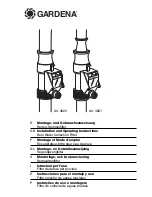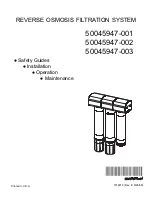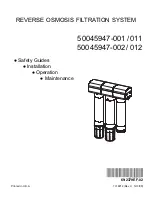
BIRM Series Filter
Installation Operation Maintenance Manual
BIRM WS1 NOV 2006 \page 6
3.3
Birm System Operation 'Frequently Asked Questions'
The main uses for a BIRM filter are for domestic and light commercial
removal of Iron, Manganese, Hydrogen Sulphide and general turbidity. The
Birm media is a catalytic media that is not used up in the reaction however
oxygen has to be present in the water to enable the oxidisation to occur. If the
feed water does not contain the necessary level of oxygen then a system for
adding this will be required
The feed water flows under pressure to the control valve on the vessel where
it is directed through to the filtration media. Birm systems built with
WS1/WS1.5 valves will bypass raw water during backwash. For this reason
the systems are set to backwash at 2:00 AM.
Maximum Iron levels:
Birm systems can be used on Iron levels of up
to 5 ppm with certain reservations. There are a number of examples
working satisfactory at higher levels.
Manganese removal:
Mang anese removal in a Birm sys tem is
dependent on the level of Iron and other contaminants in the raw water. The
greater the amount of Iron, the easier it is to remove the Manganese. With
an Iron: Manganese ratio of 10:1, the Manganese is extracted very well at a
pH of 7.0-7.5. When the ratio reaches 5:1 then the pH needs to be between
7.8-8.2. When the Manganese level exceeds the amount of Iron then a pH of
above 8.3 is required. While the pH correction media in the Birm blend will
raise the pH of acid water, it cannot raise it above 8.0 consistently if the
general level of dissolved solids is high and the Langellier index is saturated.
A full water analysis is essential when considering using the Birm system
primarily for Manganese removal.
Humic acid/tannins:
Decaying organic matter in the raw water supply
creates Humic acid or tannins, sometimes seen as light brown colour in low
pH 'peaty' water supplies. These tannins can combine and complex with Iron
and Sulphur, coating and blinding the pH correction and filter media reducing
its effectiveness. The tannin level in the raw water should be less than 2
ppm and ideally less than 1 ppm to eliminate the need for frequent changes
or rejuvenation of the filter media. With high tannin water supplies it will be
necessary to oxidise the tannins to an insoluble floc that is filtered out with
the other contaminants. The most effective oxidiser is Ozone, and an Ozone
generator with injection venturi and off-gas valve has proved to be very
successful at preventing tannin blinding. An alternative is to remove the
tannins with an Organic Scavenger, but these are not simple to install and still
operate the Birm system satisfactorily. Moreover, Organic Scavengers need
to be regenerated with Caustic Brine requiring the control and addition of two
consumables, one of which is corrosive and difficult to handle.
Chlorides:
Very high Chloride levels in the raw water can
inhibit the performance of the Birm system by
preventing Iron and







































